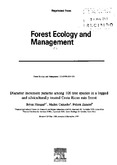| dc.description.abstract | Studies of growth rates of trees in managed neotropical forests have rarely employed complete botanical identification of all species, while published information for Central american lowland rain forests largely concerns forest free of recent disturbance. We studied diameter increments of trees in a managed Costa Rican rain forest. The Pentaclethra macroloba-dominated forest was located on low hills with Ultisols in Holdridge's Tropical Wet Forest life zone. The 540 x 540 m (29.2 ha) experimental area was lightly logged during 1989-1990. The 180 m x 180 m (3.24 ha) experimental plots comprised a 100 m x 100 m (1.0 ha) central permanent sample plot (PSP) with a 40-m wide buffer strip. Post-harvest silvicultural treatments werte liberation/refinement (in 1991) and shelterwood (in 1992), applied under a complete randomized block design with three replicates, using logged but untreated plots as controls. All live trees ó10 cm DBH in the PSPs, were identified to species data reported are for 1993-1996. Cluster analysis was used to group species on the basis of the median and quartiles of their diameter increment distributions, separating data by silvicultural treatments five diameter increment groups were established and subdivided on the basis of the adult height of each species (four categories), giving 17 species groups in the final classification. Adult height and silvicultural treatment made a significant contribution to growth rate variation. Median annual increments of the slowest-growing species groups, which featured many under -and middle story soecies, were ca. 1 mm those for the fastest growing species, which wee mainly canopy and emergents, were ca. 16 mm. All species, in the groups of very fast growth were pioneers, whether short or long-lived, though many other pioneer species did not show fast growth. The proportions of species found in groups of moderate, fast or very fast growth were greater in the silviculturally treated plots than in the controls, and one complete diameter increment group, of fast growth, was only represented in the treated plots. Crown form, crown illumination and presence of lianas in the crown, showed significant correlations with diameter increments, though the importance of these latter two variables varied with silvicultural treatment. The very fast growth groups differed from the others in having higher proportions of trees with well-formed, well-illuminated crowns and an irregular diameter distribution with relatively few individuals in the smallest DBH class. Comparison with data from other neotropical forest sites, shows that long-lived pioneers such as Vochysia ferruginea and Jacaranda copaia grow fast or very fast at all sites, while non-commercial canopy and emergent species of Chrysobalanaceae and Sapotaceae appear to be uniformly slow-growing. Growth data for tha majority of species are, however, published for the first time. | es_ES |


